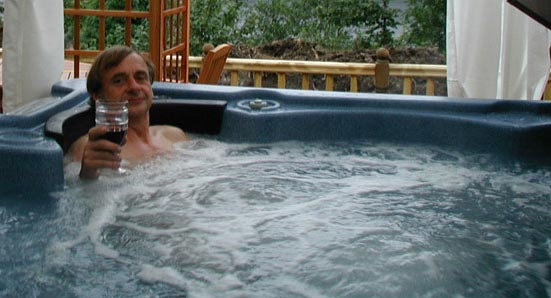Hot Tub Air Blower
 Hot Tub air blowers make the bubbles typical of Jacuzzi and hot tub action.
Hot Tub air blowers make the bubbles typical of Jacuzzi and hot tub action.
The air blower is one of the easier components to replace in a hot tub as it is not connected to the water plumbing. Usually the air blower is just plugged into the spa pack or directly to the circuit board to receive the 120 volts (or 230 volts in Europe and elsewhere). When the blower receives the voltage passed from the spa pack circuit board which is usually activated by a relay, then it turns on and forces air through the air lines that are attached to the air jets in the spa.
When the blower no longer works and a replacement is required, the blower is unplugged from the spa pack, un-mounted from the air hose and unscrewed from the floor or blower mount. The replacement blower is then simply added in its place.
 Hot Tub Blowers
Hot Tub Blowers
Hot tub blowers should be of the same voltage and also match the size of the attachment (usually 1 1/2 inch or 2 inch).
Blowers are usually held in place by mounting bolts or screws. They also sometimes have a seperate ground wire. The blower's exhaust port blows the air out of the blower similar to a hair fan.
Although many spa manufacturers tout a heated blower, many times the blower itself does not have a heater element, but takes warm cabinet air from the spa cabinet and recirculates it.
![]() Buy hot tub blowers online.
Buy hot tub blowers online.

When buying a replacement hot tub air blower, be aware of the electrical connection required. Typically,blowers may not ship with the connector needed by your particular spa. Adapter cords may be available or the correct plug configuration can be ordered.
The air blower usually mounts to the hose with a simple screw as there is no water after the air blower check valve in the plumbing line, so a screw rather than glue is enough to hold the hose in place on the blower's exhaust port.
Blower Troubleshooting
One typical cause for blower failure can be moisture buildup within the air blower which can cause a short circuit condition.
Normally, spa water is prevented from making its way into the spa blower by putting a hartford loop, or plumbing loop that goes higher than the water line thus not allowing water to get into the blower line.
As a backup, a blower check valve is put in the line in case water does get into the blower line because of an overfilled spa condition which can occur when many occupants use the spa at once causing the spa to overflow.
When that happens, or when the spa refilling is temporarily neglected causing the water to completely overflow, then water can also get over the hartford loop and into the blower.
If the spa check valve fails, then that was the last line of defense against the water intrusion, and the blower becomes wet inside and shorts out.
The one-way check valve in the blower path is usually an effective countermeasure against this happening, but if the check valve fails and causes the blower to fail, then just replacing the blower may not be enough. If there is a condition where the replacement blower also fails, then the check valve may need to be found and replaced withing the air blower air plumbing line.
Air jets that distribute the air from the hot tub air blower are commonly called air injectors and come in various shapes, sizes and colors.
Some manufacturers such as QCA Spas actually turbocharge spa jets by allowing air from the blower to be routed to the spa water jets. Normally air venturi is a natural process where a simple air knob connected to a jet or series of jets allows air to be mixed with the water to create an apparent improvement in water flow within the spa, but true turbocharging utilizes the forced air from the air blower rather than just relying on static venturi drawn air to achieve better water flow.
Hot Tub Spa.ca